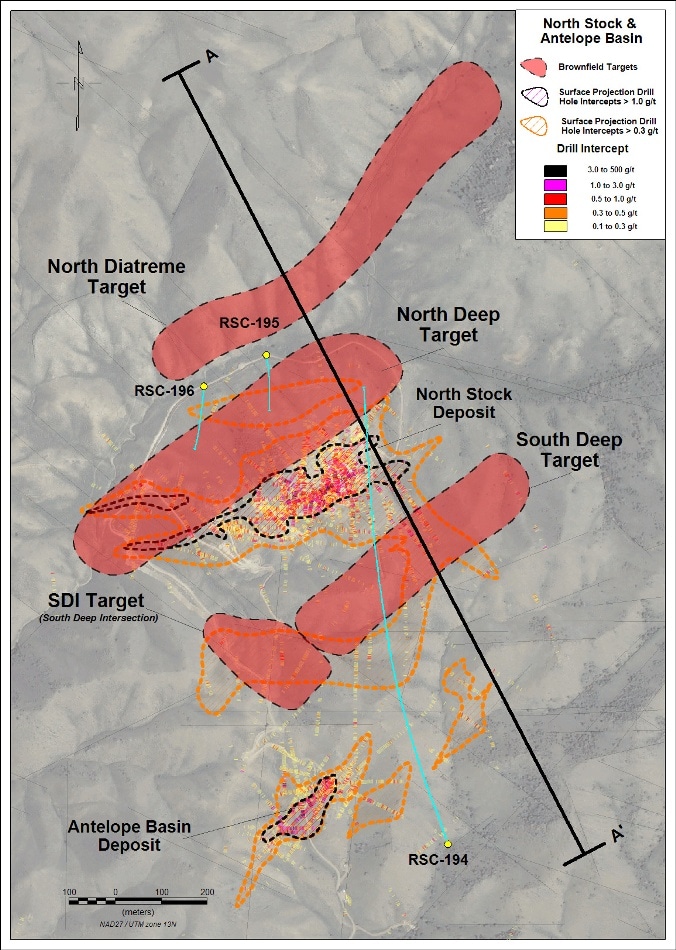Nov 22 2019
GFG Resources Inc. and its partner, Newcrest Resources Inc., a 100% owned subsidiary of Newcrest Mining Limited, have reported the completion of the 2019 drill program at the Rattlesnake Hills Gold Project in Wyoming, United States.
 Plan map view of Rattlesnake Hills Gold Project—November 2019. Image Credit: GFG Resources Inc.
Plan map view of Rattlesnake Hills Gold Project—November 2019. Image Credit: GFG Resources Inc.
The drill program, which includes 3900 m of core drilling in three holes, investigated moderate to deep gold targets close to the North Stock deposit. The receipt of final assay results is scheduled in December.
We are pleased to report that we safely and successfully completed the drill program at our Rattlesnake Hills Gold Project in Wyoming. At this early stage, the drill program was a success as all three holes hit their intended targets and intersected favourable geological and structural settings. We are encouraged by the presence of broad zones of highly altered rock and look forward to receiving the assay results and further advancing the project.
Brian Skanderbeg, President and CEO, GFG Resources Inc.
2019 Drill Program Overview
The 2019 drill program includes 3900 m of core drilling from three holes, investigating the North Deep and South Deep targets.
These targets were established in the context of a new deposit-scale alteration model produced as a result of Corescan hyperspectral scanning of historic drill core, recently concluded geophysical inversions, and the application of machine-learning technology.
Modeling of the brownfield environment indicates the presence of feeder zones to the gold mineralization at the North Stock diatreme-hosted deposit. These deep feeder zones are said to be structural corridors with targeted mineralizing fluids, intrusive activity, and gold mineralization.
Alteration is usually moderate to intense within and approaching the corridors, comprising adularia-carbonate-sericite and high-temperature clays (montmorillonite-illite). The determination of deposit scale zonation has been an important step in vectoring toward drill targets within this enormous gold system.
Drill Hole Target Descriptions
HOLE RSC-194 (1809 m long): RSC-194 was intended to test the South Deep target situated on the southeast flank of North Stock. Due to promising geology and hole trajectory, GFG Resources Inc. stretched the hole 300 m for an extra test of the North Deep target.
The South Deep target zone is 600 m in length, 100 m wide, and at a depth of 800 to 1500 m. It is related to numerous strong, sub-vertical resistivity gradients and includes several gold mineralized feldspar porphyry dikes.
Historic drilling up-dip of the target area shows the presence of high-grade zones of gold mineralization like RSC-027, which intersected 2.49 g of gold per ton (g/t Au) over 22.9 m in a modified interval of heterolithic volcanic breccia, monolithic schist breccia, and feldspar porphyry with intense, vuggy adularia and related sericite-montmorillonite-illite-carbonate.
The hole intersected quartz monzodiorite from 832 to 977 m, which is the down-dip extension of the dike that is the target of the gold mineralization at Antelope Basin. This dike was intersected by veinlets of quartz, calcite, and pyrite and different amounts of sericite and other clays.
The hole extended through the South Deep Target from 1122 to 1338 m and crosscut zones of weakly to moderately modified schist that was intersected by many dikes, with a thickness of up to 13 m in width, including moderate to concentrated carbonate and potassic alteration with disseminated pyrite.
The North Deep target is situated under North Stock and is comparable to South Deep in size, alteration, geology, and geophysical signature. The target is said to be the down-dip extension of the mineralization that has been defined at North Stock.
The hole penetrated the target zone at a down-hole depth of 1692 m, where it passed from Precambrian schist into potassically-altered heterolithic breccia and then into an altered feldspar porphyry, where it terminated at a depth of 1809 m. The breccia as well as feldspar porphyry were mineralized with trace to 5% pyrite.
HOLE RSC-195/196 (1081 and 1010 m long): RSC-195 and RSC-196 investigated the North Deep target situated straight under the North Stock deposit. The target is 700 m long, 100 m wide, and at a depth of 800 to 1500 m. It is directly related to the North Stock diatreme and diatreme contact, has a strong sub-vertical resistivity gradient, and is host to phonolite and feldspar porphyry intrusive bodies.
This corridor had not been tested through historic deep drilling, but at shallow to intermediate depths, it hosts the North Stock gold deposit and related moderate to intense adularia with carbonate-sericite-montmorillonite alteration.
RSC-196 was collared 200 m to the west of RSC-195 as a step-out hole along the North Deep target. Both holes crosscut extensive zones of heterolithic breccia and phonolite with moderate to strong carbonate and potassic alteration with trace to 5% pyrite veinlets and disseminations.
GFG and Newcrest Partnership Overview
In September 2018, GFG and Newcrest signed an option and joint venture agreement. Under the agreement terms, Newcrest has the right to obtain, in various stages, up to 75% of the Rattlesnake Hills Gold Project by finishing a chain of exploration and development expenditures and making staged option cash payments to GFG.
Newcrest is presently in the option phase of the program and has invested around US$4.6 million in exploration expenditures, exceeding its obligation of US$2.6 million under the terms of the agreement. GFG continues as the project operator during this stage of the agreement.